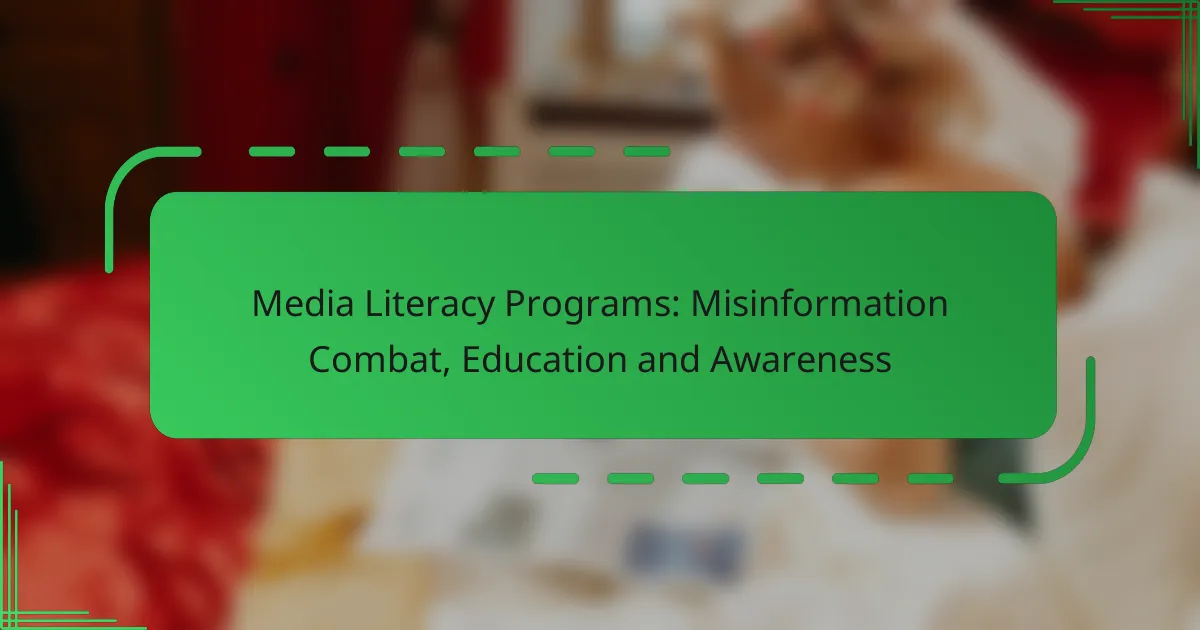The landscape of media coverage is undergoing a profound transformation, marked by a shift towards digital platforms and a growing focus on local news and social media. These changes not only affect how information is consumed but also play a crucial role in shaping public perception and opinion through the framing of issues. As technology evolves and consumer behaviors shift, the dynamics of news production and distribution continue to adapt, highlighting the intricate relationship between media trends and societal impact.
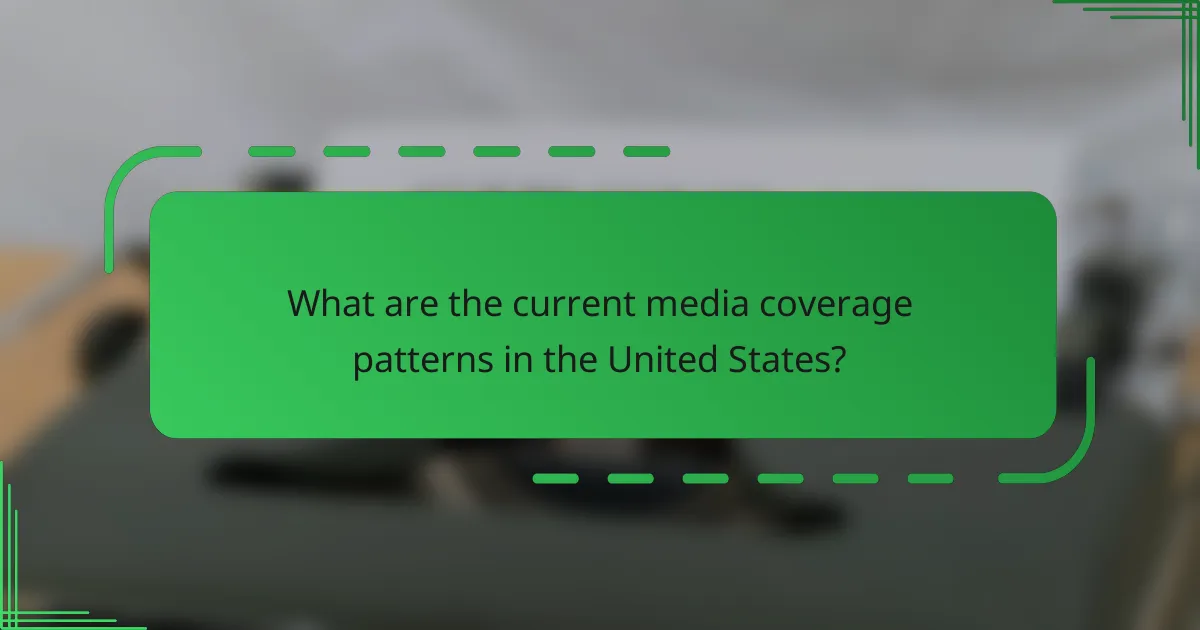
What are the current media coverage patterns in the United States?
The current media coverage patterns in the United States reflect a significant shift towards digital platforms, with an increasing emphasis on local news and social media engagement. These trends indicate how audiences consume information and the evolving landscape of journalism.
Increased digital media presence
Digital media has become the dominant source of news for many Americans, with online platforms outpacing traditional print and broadcast outlets. This shift allows for faster dissemination of information and greater accessibility, as news can be consumed on various devices at any time.
News organizations are investing in their online presence, utilizing multimedia content such as videos, podcasts, and interactive graphics to engage audiences. This trend has led to a more dynamic news environment, where stories can be updated in real-time and tailored to specific audience interests.
Shift towards social media platforms
Social media platforms like Facebook, Twitter, and Instagram are increasingly central to how news is shared and consumed. Many users now rely on these platforms for breaking news and updates, often prioritizing content that is easily shareable and visually appealing.
This shift has prompted news organizations to adapt their strategies, focusing on creating shareable content and engaging directly with audiences. However, it also raises concerns about misinformation and the need for media literacy among consumers to discern credible sources.
Focus on local news reporting
There is a renewed emphasis on local news reporting, as communities seek information that directly impacts their lives. Local news outlets are crucial for covering events, issues, and developments that may not receive attention from national media.
In response to this demand, many media organizations are increasing their investment in local journalism, often collaborating with community members to ensure coverage is relevant and accurate. This trend supports the idea that informed communities are essential for a healthy democracy.
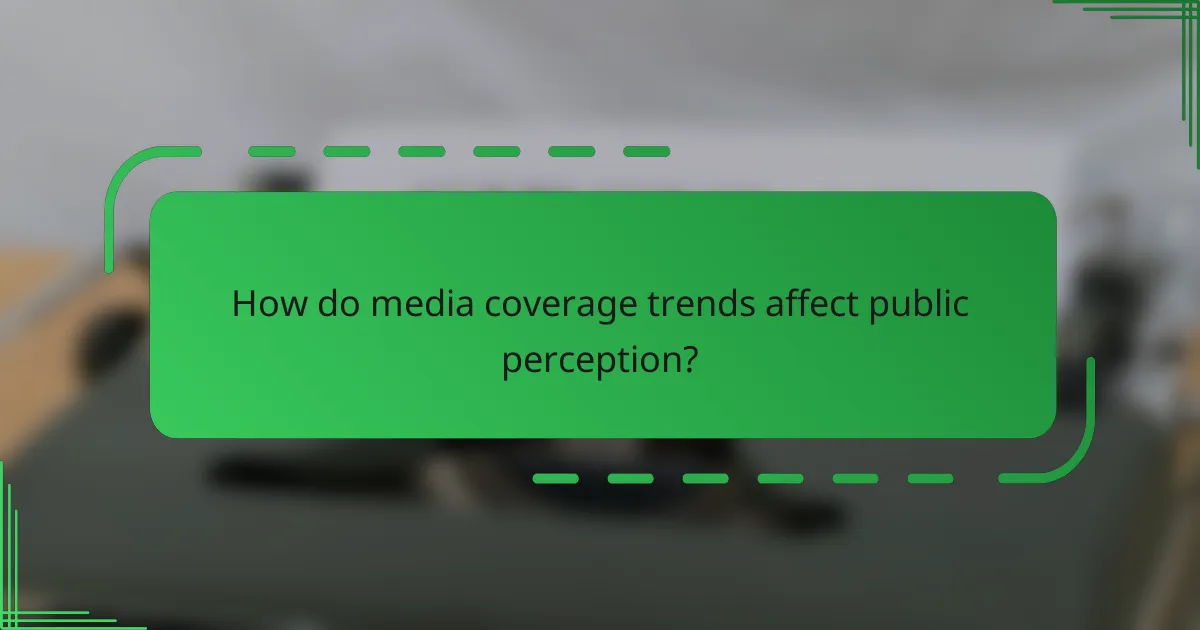
How do media coverage trends affect public perception?
Media coverage trends significantly shape public perception by influencing how issues are framed and prioritized. The way stories are reported can create biases, highlight certain viewpoints, and ultimately sway public opinion on various topics.
Influence on public opinion
Media coverage plays a crucial role in shaping public opinion by determining which issues receive attention and how they are presented. For instance, extensive coverage of a health crisis can lead to heightened awareness and concern among the public, while minimal coverage may result in indifference. The framing of stories, such as emphasizing negative outcomes or positive developments, can further influence perceptions.
Additionally, social media has amplified the impact of media trends, allowing narratives to spread rapidly. This can create echo chambers where certain viewpoints dominate, reinforcing existing beliefs and potentially polarizing public opinion.
Impact on trust in media
Trends in media coverage can significantly affect the public’s trust in media outlets. When coverage is perceived as biased or sensationalized, trust may decline, leading audiences to seek alternative sources of information. For example, consistent reporting that favors one political perspective can alienate viewers who feel misrepresented.
Moreover, transparency in reporting practices and adherence to journalistic standards are critical for maintaining trust. Media organizations that openly correct errors and provide context tend to foster greater confidence among their audiences. Regular audience engagement and feedback mechanisms can also enhance trust and credibility.

What are the key factors driving media coverage changes?
Key factors driving changes in media coverage include technological advancements, shifts in consumer behavior, and regulatory impacts. These elements influence how news is produced, distributed, and consumed, ultimately shaping the media landscape.
Technological advancements
Technological advancements play a crucial role in transforming media coverage. Innovations such as social media platforms, mobile devices, and artificial intelligence have enabled faster news dissemination and broader audience reach. For example, real-time reporting through social media allows journalists to share updates instantly, impacting traditional news cycles.
Moreover, the rise of data analytics tools helps media outlets understand audience preferences, allowing for more targeted content. This shift towards personalized news can enhance engagement but may also lead to echo chambers, where consumers are exposed only to information that aligns with their views.
Changes in consumer behavior
Changes in consumer behavior significantly affect media coverage patterns. As audiences increasingly prefer on-demand content, traditional media outlets are adapting by offering digital subscriptions and streaming services. This shift has led to a decline in print media and a rise in online news consumption.
Additionally, consumers are more likely to seek out diverse viewpoints and engage with interactive content. Media organizations must respond by diversifying their coverage and incorporating multimedia elements to attract and retain viewers.
Regulatory impacts
Regulatory impacts can shape media coverage by influencing what can be reported and how. Laws regarding data privacy, copyright, and misinformation can affect the way news organizations operate. For instance, regulations like the General Data Protection Regulation (GDPR) in Europe impose strict guidelines on data handling, which can limit how media companies collect and use audience data.
Furthermore, government policies regarding media ownership can affect competition and diversity in coverage. In regions with stringent media regulations, outlets may face challenges in providing comprehensive news, potentially leading to a less informed public.
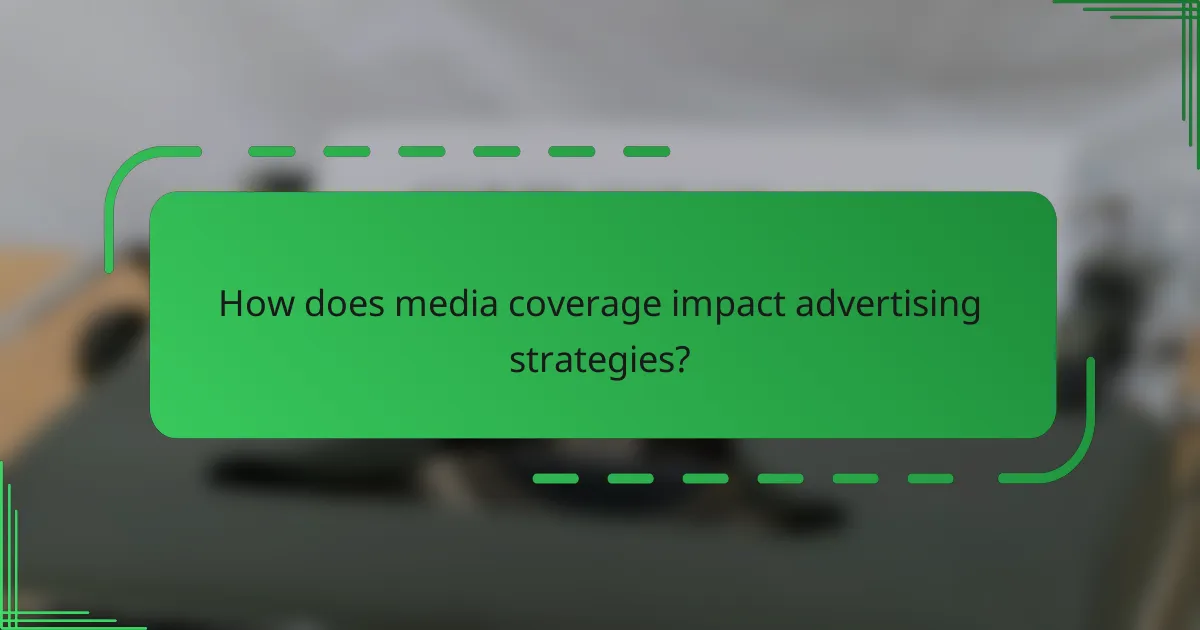
How does media coverage impact advertising strategies?
Media coverage significantly influences advertising strategies by shaping public perception and consumer behavior. Advertisers must adapt their approaches based on the tone and volume of media coverage to effectively reach their target audiences.
Shift to programmatic advertising
The rise of media coverage has led to a notable shift towards programmatic advertising, which automates the buying and selling of ad space. This method allows advertisers to respond quickly to media trends, optimizing their campaigns in real-time based on current events and audience engagement.
For instance, if a particular news story gains traction, advertisers can adjust their programmatic campaigns to target relevant demographics, ensuring their messages align with the ongoing conversation. This flexibility can enhance ad effectiveness and ROI.
Increased focus on targeted campaigns
As media coverage becomes more segmented and specialized, advertisers are increasingly focusing on targeted campaigns. By leveraging data analytics, brands can identify specific audience segments that are most likely to engage with their products or services based on current media narratives.
Targeted campaigns can include personalized messaging and tailored content that resonates with the audience’s interests, driven by media trends. For example, during a health crisis, brands in the wellness sector might emphasize their products’ benefits in relation to the news, thereby increasing relevance and engagement.

What metrics are used to analyze media coverage effectiveness?
To analyze media coverage effectiveness, several key metrics are utilized, including engagement rates, reach and impressions, and sentiment analysis. These metrics provide insights into how well media content resonates with audiences and its overall impact.
Engagement rates
Engagement rates measure how actively audiences interact with media content. This includes likes, shares, comments, and other forms of interaction that indicate interest. A higher engagement rate often signifies that the content is resonating well with the target audience.
To calculate engagement rates, divide the total interactions by the total reach or impressions and multiply by 100 to get a percentage. For example, if a post receives 200 interactions from 1,000 impressions, the engagement rate would be 20%.
When analyzing engagement, consider the context of the content and the platform. Different platforms may have varying benchmarks for what constitutes a good engagement rate.
Reach and impressions
Reach refers to the total number of unique users who see a piece of media, while impressions count the total number of times the content is displayed, regardless of whether it was clicked or not. Both metrics are crucial for understanding the visibility of media coverage.
For example, if a news article is shared widely, it may have a high reach but a lower number of impressions if users do not click through to read it. Conversely, a post may have many impressions if it is repeatedly shown to the same users.
To improve reach, consider targeting specific demographics or utilizing paid promotions. Monitoring these metrics helps in adjusting strategies to maximize visibility.
Sentiment analysis
Sentiment analysis assesses the emotional tone behind media coverage, categorizing it as positive, negative, or neutral. This metric is essential for understanding public perception and the overall impact of the coverage.
Tools for sentiment analysis often use natural language processing to evaluate text from articles, social media posts, and comments. For instance, a predominance of positive sentiment in coverage can indicate successful messaging, while negative sentiment may highlight areas needing improvement.
When conducting sentiment analysis, ensure to consider the context and nuances of language, as sarcasm or cultural references can skew results. Regularly monitoring sentiment can guide future communication strategies and enhance audience engagement.
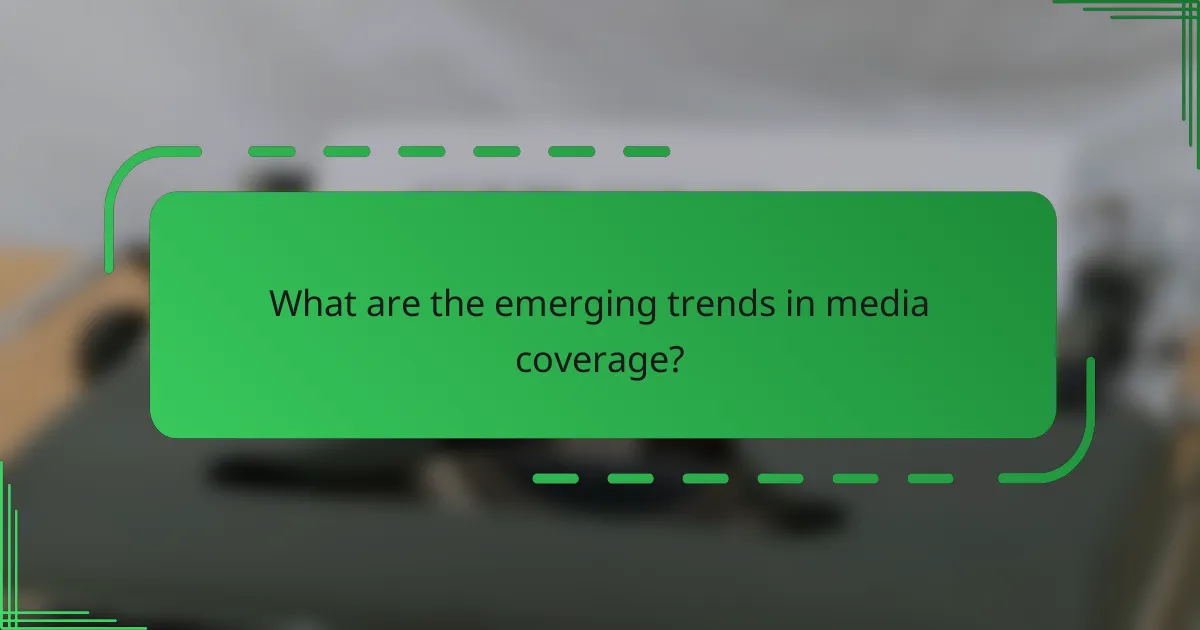
What are the emerging trends in media coverage?
Emerging trends in media coverage include the integration of artificial intelligence and the rise of multimedia storytelling. These trends are reshaping how news is reported and consumed, emphasizing efficiency, engagement, and diverse formats.
Rise of artificial intelligence in journalism
The rise of artificial intelligence (AI) in journalism is transforming news production and distribution. AI tools are being used for tasks such as data analysis, content generation, and audience targeting, allowing news organizations to operate more efficiently.
For example, AI can analyze large datasets to identify trends and generate reports in real-time, which can significantly reduce the time journalists spend on research. However, reliance on AI also raises concerns about accuracy and bias, making it crucial for media outlets to maintain editorial oversight.
Growth of multimedia storytelling
Multimedia storytelling is increasingly popular as it combines text, images, video, and audio to create richer narratives. This approach caters to diverse audience preferences and enhances engagement, making stories more compelling and shareable across platforms.
News organizations are leveraging platforms like social media and websites to deliver interactive content, such as infographics and video clips. To effectively implement multimedia storytelling, journalists should focus on clear messaging and ensure that all elements complement each other, avoiding information overload.
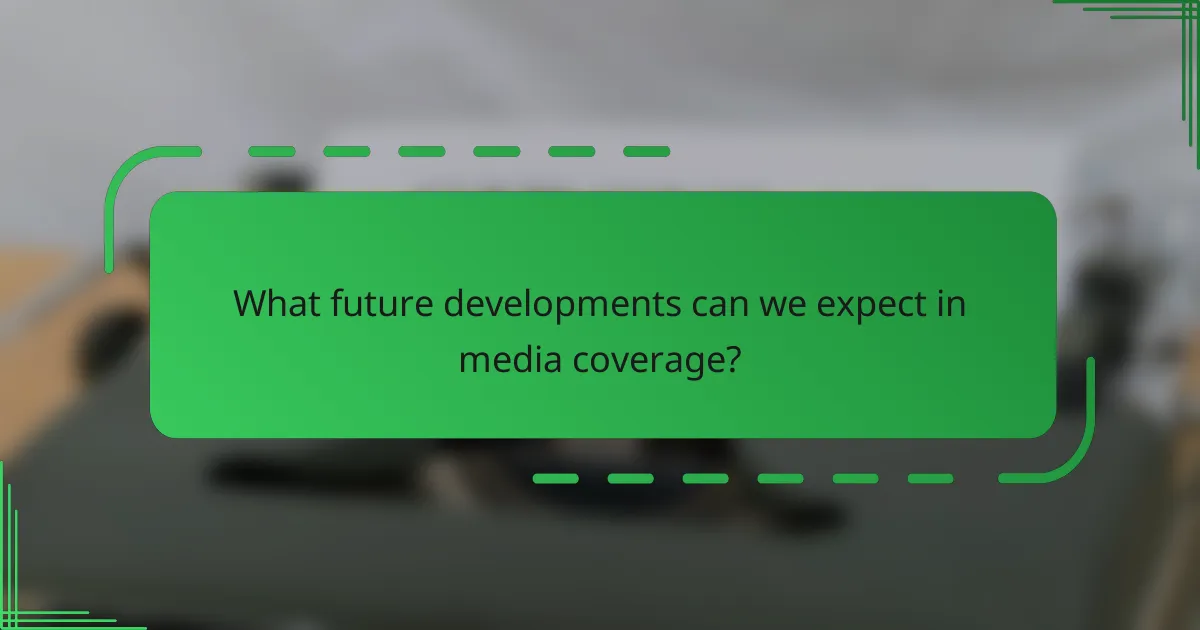
What future developments can we expect in media coverage?
Future developments in media coverage will likely focus on technological advancements and evolving audience preferences. Key trends include the integration of augmented reality, enhanced data analytics, and a shift towards more personalized content delivery.
Integration of augmented reality
The integration of augmented reality (AR) in media coverage allows for immersive storytelling that enhances viewer engagement. AR can overlay digital information onto the real world, providing audiences with interactive experiences that traditional media cannot offer.
For example, news outlets may use AR to visualize complex data, such as election results or environmental changes, making it easier for viewers to understand the implications. This technology can also be employed in live broadcasts, allowing viewers to see additional context or information in real-time.
However, media organizations must consider the accessibility of AR technologies. Not all audiences may have the necessary devices or internet speeds to fully engage with AR content. Ensuring that AR experiences are available across various platforms will be crucial for widespread adoption.

